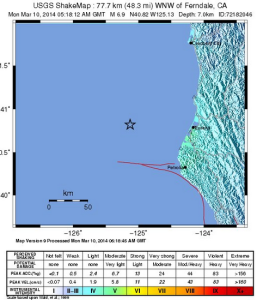Yesterday night, March 9th, a very powerful earthquake with a magnitude of M6.9 struck off the coast of Eureka in  the northern part of California. This Quake shook regions as far away as San Francisco and some parts of Oregon. The United States Geological Survey said that the earthquake struck 10 miles deep occurred at 10:18 p.m. local time. The Epicenter of the quake was about 50 miles west of Eureka, California, in the pacific Ocean. There were more than 15 aftershocks recorded, the largest one was M4.6. More aftershocks are expected this week. Although buildings nearby shook for about 20 seconds, there has been little damage reported in the region. Although the National Tsunami Warning Center initially reported the earthquake, they said there was no tsunami danger for the region.
the northern part of California. This Quake shook regions as far away as San Francisco and some parts of Oregon. The United States Geological Survey said that the earthquake struck 10 miles deep occurred at 10:18 p.m. local time. The Epicenter of the quake was about 50 miles west of Eureka, California, in the pacific Ocean. There were more than 15 aftershocks recorded, the largest one was M4.6. More aftershocks are expected this week. Although buildings nearby shook for about 20 seconds, there has been little damage reported in the region. Although the National Tsunami Warning Center initially reported the earthquake, they said there was no tsunami danger for the region.
The Earthquake occurred to the south of the Cascadia Subduction zone, which is close to the Mendocino Triple Junction, a point where three plates (Pacific, Gorda and North America) meet. In the past, earthquakes in the triple junction area have happened not only along the plate boundaries, but also in the smaller Gorda plate which is diminishing as it continues subducting under the North American plate to the east.
This event is the largest to hit this region since 1992 when a 7.2 magnitude earthquake struck south of Eureka near Petrolia. That quake killed nearly 100 people and caused significant damage. Yesterday’s earthquake was eighth recorded in the area since 1900. The other dates in which similar or larger magnitude earthquakes occurred were 1922, 1923, 1980, 1992, 1994, and 2005. Approximately once every three years there is a M6.0 or greater earthquake in the region.